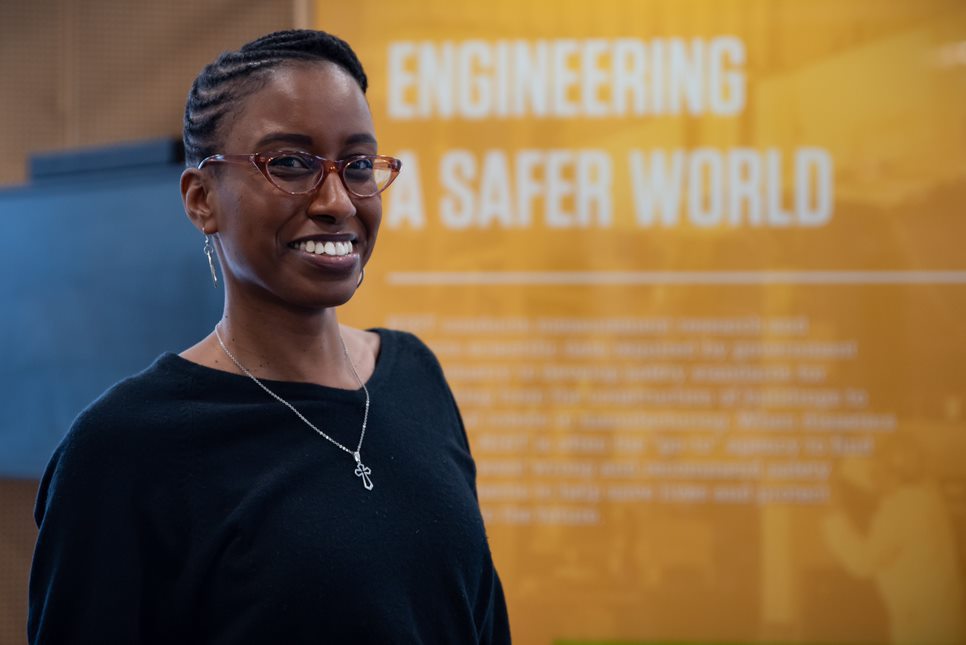Taking Measure
Just a Standard Blog
How My Childhood Fascination With Bridges Helped Me Build a Career Protecting People and Buildings From Natural Disasters

In honor of National Engineers Week this week and Introduce a Girl to Engineering Day tomorrow, Taking Measure asked NIST research engineer Jazalyn Dukes to tell us what inspired her career and to give some advice to girls considering a career in structural and civil engineering.
Growing up on the East Coast in Chesapeake, Virginia, I was surrounded by bodies of water. That meant crossing many bridges and even bridge-tunnels to get most places.
I was fascinated by how bridges and tunnels could take you over and under water to get you where you needed to go.
This got me interested in structures and the engineering behind them.
How did they work? How were they built? How did they stay standing with all those vehicles going over them every day? It was fascinating to me.
During high school, I attended the National Summer Transportation Institute at Hampton University, the Virginia Governor’s School Summer Program, and other after-school programs. These programs helped me learn that I wanted to pursue a career in engineering. I loved math and physics, and engineering seemed like the perfect combination of my interests.
I attended the University of Maryland, College Park, with a major in civil engineering. It was there that I learned the specific field I was interested in was called structural engineering.
After getting my Ph.D. at Georgia Tech, I worked for the U.S. Navy doing engineering work at the Naval Surface Warfare Center. I joined NIST in 2017 to pursue my interests in structural engineering.

NIST Structural Engineers Work to Keep Buildings Safe Against Natural Hazards and a Changing Climate
Today, much of my work focuses on analyzing structures under earthquake loads. Earthquake loads, or structural loads in general, are the forces that can be exerted on a structure such as a building or its components. I look at computer and mathematical models to determine the seismic loads that buildings can handle. I analyze steel and concrete structures and figure out the probability of collapse from such loads.
I’m currently analyzing the retrofit of concrete structures using a material called fiber-reinforced polymers (FRP). Essentially, these materials are very strong fibers that are wrapped on the outside of concrete structures. They can give buildings more strength and resistance against earthquakes.
FRP has gained a wide variety of uses in the civil engineering field in the past two decades. These materials have many advantageous qualities for use in construction. They are lightweight, easy to apply, and corrosion resistant. Research on these materials and their application in construction advances the knowledge of the performance and durability of the materials among practicing engineers. Engineers may opt to include FRP in their design or retrofit of structures after learning of the advantages.
I am also part of the National Construction Safety Team working on the technical investigation into Hurricane Maria’s impact on Puerto Rico. We’re studying the effects of high winds and heavy rainfall on critical buildings such as hospitals and schools.
As part of the Hurricane Maria team, I look at the impact of the hurricane on buildings and wireless communication systems. I’m taking the lessons learned from this event and making observations on how we can make buildings and other structures more resilient to future hurricanes.
We’re trying to answer the question: What recommendations can we make to improve building codes, standards and practices so that structures and communities can better withstand these types of events?
The effect of climate change on the field of structural engineering is becoming more important, as buildings and infrastructure encounter changing and intensifying hazards. Building codes are based on expected hazards for a particular area. The hazards in Florida are different from natural hazard events expected in the Midwest.
But what was expected in a climate 10 years ago might not be the same today and definitely won’t be the same in the future. So, climate change will need to be considered in future building codes and accounted for in our research and practice. It’s a growing conversation in this area of engineering.
Buildings and communities may now be exposed to higher wind loads in a hurricane or tornado, changing flood patterns, or more intense storm surges. That’s all in addition to the other stressors on buildings. Changes due to climate are especially important to consider when looking at buildings from a multi-hazard perspective.
These factors will have to influence future building codes and standards and engineers’ thinking as we adapt to the changing climate.
Structural Engineers Keep the Building Above Your Head
Structural engineering is a rewarding career, but people generally don’t know much about it and the impact it has on their lives.
Everyone knows about architects; many children want to be architects when they grow up. Yes, architects have an important job in designing and planning a building’s appearance and function. However, structural engineers have an equally important job in the design and construction process of a building. Structural engineers make sure the structural system is sound, compliant with codes, and constructible .
It’s a structural engineer’s job to make sure buildings are built safely and protect occupants from the many possible hazards the building may encounter during its expected lifespan.
Every person using a building, driving over a bridge, or benefiting from a local power plant or dam has been impacted by the work of a structural engineer. I would love to see more young people pursue careers as structural engineers!
You Can Build a Dream Career One Question at a Time
I encourage young people, especially girls and women, to think about a career in the science, technology, engineering and math fields (STEM). Volunteer or join clubs where you can meet other people who are interested or involved in STEM fields. It’s a good way to meet experts and gain experience.
Ask them lots of questions. You may be naturally shy, but if you have a question, ask it. That’s what scientists and engineers do; we ask questions and find the answers.
When I was an undergraduate student, I was always asking questions of people in the field to see what I liked and what I didn’t like. That’s the best way to steer yourself toward a career that matches your interests.
In school, I thought I was going to study transportation engineering because I was interested in bridges. But I quickly learned transportation engineers do not design bridges. They analyze and design traffic flows. That’s not what I wanted to do, so I switched my track completely after I figured that out. There are so many different fields of study. You need to understand the different aspects to figure out what you really want to do.
In any field, but especially in science and engineering, I encourage women to speak up and advocate for themselves. Let someone know you would like to be involved in this project or that club. In addition to being an advocate for yourself, find a mentor who can help guide you toward your goals.
Find someone who can advocate for you. I had advisers and mentors in undergrad and graduate school who really advocated for me and helped guide me in my career path. Once I started at NIST, I gained additional mentors who helped me steer my career. I’m grateful I can still call on these mentors for advice and encouragement.
Although my field of structural engineering, and engineering as a whole, is predominantly male, I’ve been fortunate in that I haven’t experienced challenges related to this specific imbalance. I’ve gotten used to it, but I hope in the future, things are different.
I hope to encourage more young women to choose civil engineering and structural engineering. It’s a career that can impact and improve people’s lives.






Thanks